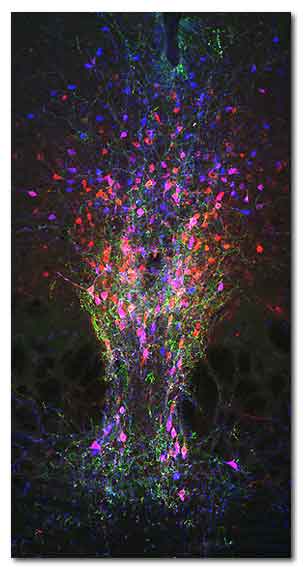|
New research identifies a group of neurons that can
help us stay awake when it matters: Caltech
researchers have identified a neural circuit in the
brain that controls wakefulness.
The findings have implications for treating
insomnia, oversleeping, and sleep disturbances that
accompany other neuropsychiatric disorders, such as
depression.

Dopaminergic neurons genetically engineered to
express fluorescing genes. The fluorescence is used
to measure activity of the neurons, which have been
implicated in the sleep/wake cycle.
Credit: Courtesy of the Gradinaru laboratory
The work was done in the laboratory of Viviana
Gradinaru, assistant professor of biology and
biological engineering, Heritage Medical Research
Institute Investigator, and director of the Center
for Molecular and Cellular Neuroscience of the
Tianqiao and Chrissy Chen Institute for Neuroscience
at Caltech.
Gradinaru and her team decided to examine a region
of the brain, called the dorsal raphe nucleus, where
there are an under-studied group of dopamine neurons
called dorsal raphe nucleus neurons, or DRNDA
neurons.
"People who have damage in this part of their brain
have been shown to experience excessive daytime
sleepiness, but there was not a good understanding
of the exact role of these neurons in the sleep/wake
cycle and whether they react to internal or external
stimuli to influence arousal" says Gradinaru.
The team studied DRNDA neurons in mice, which are a
model organism for studying the human brain.
First, the team measured DRNDA activity while the
animals encountered salient stimuli, such as the
arrival of a potential mating partner, or a sudden
unpleasant sensation, or food.
The DRNDA neurons were highly active during these
events, which led the researchers to theorize that
the neurons send signals of salience and arousal,
which can then modulate the state of sleep or
wakefulness.
"We then measured DRNDA activity throughout the
sleep/wake cycle and found that these neurons are
least active when the animal is sleeping and
increase in activity as the animal is waking up,"
says Ryan Cho, a graduate student and the first
author on the paper.
"We aimed to discover whether this was just a
correlation or if the activity of the neurons was
actually causing changes in sleep-wake states."
The researchers used a technique called optogenetics
to engineer DRNDA cells to be stimulated by light.
After stimulating these neurons with light during
the time that the animal would normally sleep,
Gradinaru and her team found that the mouse woke up
from sleep and remained awake.
The reverse was true when the activity of DRNDA was
chemically silenced—the animal was likely to fall
asleep, even in the face of motivationally important
stimuli, such as the odor of a predator or a mating
partner. This implied that activity of the DRNDA
neurons truly governed sleep-wake behaviors.
Finally, the researchers examined the role of these
neurons in awaking due to external stimuli.
The neurons' activity was silenced with optogenetics,
and a loud noise was played while the animals were
asleep.
Whereas control mice often woke up, the mice with
blocked DRNDA often ignored the sound and remained
asleep.
"These experiments showed us that DRNDA cells are
necessary for full wakefulness in the face of
important stimuli in mice," Gradinaru says.
"DRNDA neurons are found analogously in humans, and
while they have not been studied in depth, their
degeneration has been correlated with excessive
daytime sleepiness in patients with
neurodegenerative disorders such as multiple systems
atrophy and Lewy body dementia.
Further work is necessary to establish causation in
humans and to test the potential of the DRNDA as a
therapeutic target for insomnia or oversleeping, and
for sleep disturbances that accompany other
psychiatric disorders such as depression, bipolar
disorder, and schizophrenia."
For more information
Dorsal Raphe Dopamine Neurons Modulate Arousal and
Promote Wakefulness by Salient Stimuli.
Other co-authors are postdoctoral scholars Jennifer
Treweek (BS '04), Alon Greenbaum, and J. Elliott
Robinson; former senior research scientist Cheng
Xiao; and Caltech lecturer Lindsay Bremner.
Link...
Caltech
California Institute of Technology
Link...
MDN |